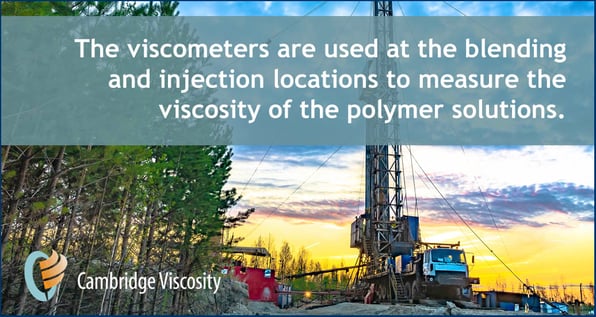 In mature, oil-producing reservoirs, conditions like natural fissions in the reservoir rock or resistance from heavier or more viscous oils require enhanced oil recovery (EOR) injection techniques. Polymer flooding is one EOR technique that is widely used because it can significantly improve oil recovery over conventional flooding. It uses polymer solutions in an aqueous medium to increase oil recovery by reducing the water-to-oil mobility ratio. Managing the viscosity of the EOR polymers at the well head supports efficient oil production, while helping to reduce the amount of EOR polymer needed.
In mature, oil-producing reservoirs, conditions like natural fissions in the reservoir rock or resistance from heavier or more viscous oils require enhanced oil recovery (EOR) injection techniques. Polymer flooding is one EOR technique that is widely used because it can significantly improve oil recovery over conventional flooding. It uses polymer solutions in an aqueous medium to increase oil recovery by reducing the water-to-oil mobility ratio. Managing the viscosity of the EOR polymers at the well head supports efficient oil production, while helping to reduce the amount of EOR polymer needed.
It's common to see a single polymer mixing station combined with multiple platforms for polymer injection, with one platform for oil recovery at each oil well. The viscometers are used at the blending and injection locations to measure the viscosity of the polymer solutions. Then, viscosity data is sent to a centralized control room, where the viscosity data is used to calculate the ideal operating parameters to maximize oil production. Small changes in concentration result in significant changes in viscosity. Measuring and controlling the viscosity of the oil to the target can result in millions of dollars per year.
CHALLENGE
Polymer concentration has a significant impact on the viscosity of the solution. The polymers tend to be non-Newtonian, with the viscosity varying with changing shear rates and time. This means they need to be measured at relatively low shear rates. A measurement at points at each platform is used to attain the ideal viscosity. Then, a final measurement is made at the well head for the final viscosity.
SOLUTIONS
The requirement of measuring at injection points under pressure at each platform, combined with the non-Newtonian fluid being pumped, makes in-line viscosity an ideal solution. The ViscoPro 2100 is the only system that can meet the pressure, temperature, and viscosity requirements, while being at relatively low shear.
The ViscoPro 2100 with the SPL-393 sensor measures the viscosity of oil solutions with a repeatability of +/- 0.8 %. It also measures at lower shear rates, allowing for precise control of the polymer. The SPL-393 can withstand pressures up to 1000 psi, with a special version capable of pressures up to 2500 psi. The ViscoPro 2100 transmitter has an intuitive user interface and can export the data for further analysis and custom reports.
RESULTS
Customers using the ViscoPro 2100 in oil recovery applications experience significant results, including:- Achieving as much as a 20% increase in the amount of oil extracted
- Significantly reducing the amount of food-grade polymer needed.
- Avoiding oil recovery degradation caused by viscosity-driven instability
- Achieving excellent repeatability, even under challenging process conditions
- Maximizing oil production while minimizing EOR polymer costs





